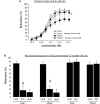Cyclooxygenase-2 inhibition restored endothelium-mediated relaxation in old obese zucker rat mesenteric arteries
- PMID: 21423385
- PMCID: PMC3059951
- DOI: 10.3389/fphys.2010.00145
Cyclooxygenase-2 inhibition restored endothelium-mediated relaxation in old obese zucker rat mesenteric arteries
Abstract
Metabolic syndrome is associated with reduced endothelial vasodilator function. It is also associated with the induction of cyclooxygenase-2 (COX2), which produces vasoactive prostanoids. The frequency of metabolic syndrome increases with age and aging per se is a risk factor associated with reduced endothelium-mediated relaxation. Nevertheless, the combined effect of aging and metabolic syndrome on the endothelium is less known. We hypothesized that COX2 derived prostanoids may affect endothelium function in metabolic syndrome associated with aging. We used obese Zucker rats, a model of metabolic syndrome. First order mesenteric arteries were isolated from 4- and 12-month-old rats and acetylcholine (endothelium)-dependent relaxation determined using wire-myography. Endothelium-mediated relaxation, impaired in young Zucker rats (89 versus 77% maximal relaxation; lean versus Zucker), was further reduced in old Zucker rats (72 versus 51%, lean versus Zucker). The effect of the nitric oxide-synthesis inhibitor L-NAME on the relaxation was reduced in both young and old Zucker rats without change in eNOS expression level. COX inhibition (indomethacin) improved acetylcholine-mediated relaxation in old obese rats only, suggesting involvement of vasoconstrictor prostanoids. In addition, COX2 inhibition (NS398) and TxA2/PGH2 receptor blockade (SQ29548) both improved relaxation in old Zucker rat arteries. Old Zucker rats had the highest TxB2 (TxA2 metabolite) blood level associated with increased COX2 immunostaining. Chronic COX2 blockade (Celecoxib, 3 weeks) restored endothelium-dependent relaxation in old Zucker rats to the level observed in old lean rats. Thus the combination of aging and metabolic syndrome further impairs endothelium-dependent relaxation by inducing an excessive production of COX2-derived vasoconstrictor(s); possibly TxA2.
Keywords: aging; cyclooxygenase-2; endothelium; metabolic syndrome; resistance arteries; vasodilatation.
Figures






References
-
- Bagi Z., Erdei N., Toth A., Li W., Hintze T. H., Koller A., Kaley G. (2005). Type 2 diabetic mice have increased arteriolar tone and blood pressure: enhanced release of COX-2-derived constrictor prostaglandins. Arterioscler. Thromb. Vasc. Biol. 25, 1610–161610.1161/01.ATV.0000172688.26838.9f - DOI - PubMed
-
- Belin de Chantemele E. J., Vessieres E., Guihot A. L., Toutain B., Maquignau M., Loufrani L., Henrion D. (2009). Type 2 diabetes severely impairs structural and functional adaptation of rat resistance arteries to chronic changes in blood flow. Cardiovasc. Res. 81, 788–79610.1093/cvr/cvn334 - DOI - PubMed
-
- Ben Driss A., Devaux C., Henrion D., Duriez M., Thuillez C., Levy B. I., Michel J. B. (2000). Hemodynamic stresses induce endothelial dysfunction and remodeling of pulmonary artery in experimental compensated heart failure. Circulation 101, 2764–2770 - PubMed
LinkOut - more resources
Full Text Sources
Research Materials

